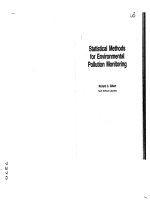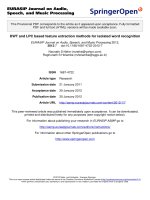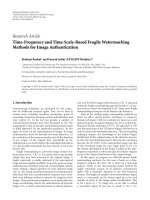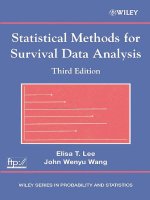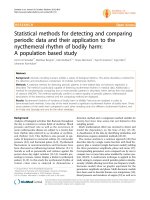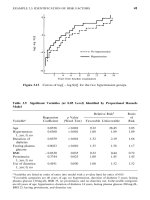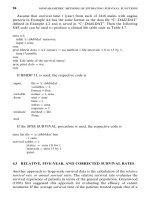2014 register based statistics statistical methods for administrative data
Bạn đang xem bản rút gọn của tài liệu. Xem và tải ngay bản đầy đủ của tài liệu tại đây (1.96 MB, 324 trang )
Register-based Statistics
WILEY SERIES IN SURVEY METHODOLOGY
Established in Part by Walter A. Shewhart and Samuel S. Wilks
Editors: Mick P. Couper, Graham Kalton, Lars Lyberg, J. N. K. Rao, Norbert Schwarz,
Christopher Skinner
A complete list of the titles in this series appears at the end of this volume.
Register-based Statistics
Statistical Methods for Administrative Data
Second Edition
Anders Wallgren and Britt Wallgren
Formerly of the Department of Research and
Development at Statistics Sweden
This edition first published 2014
© 2014 John Wiley & Sons, Ltd
Registered office
John Wiley & Sons Ltd, The Atrium, Southern Gate, Chichester, West Sussex, PO19 8SQ, United Kingdom
For details of our global editorial offices, for customer services and for information about how to apply for permission
to reuse the copyright material in this book please see our website at www.wiley.com.
The right of the author to be identified as the author of this work has been asserted in accordance with the Copyright,
Designs and Patents Act 1988.
All rights reserved. No part of this publication may be reproduced, stored in a retrieval system, or transmitted, in any
form or by any means, electronic, mechanical, photocopying, recording or otherwise, except as permitted by the UK
Copyright, Designs and Patents Act 1988, without the prior permission of the publisher.
Wiley also publishes its books in a variety of electronic formats. Some content that appears in print may not be
available in electronic books.
Designations used by companies to distinguish their products are often claimed as trademarks. All brand names
and product names used in this book are trade names, service marks, trademarks or registered trademarks of their
respective owners. The publisher is not associated with any product or vendor mentioned in this book.
Limit of Liability/Disclaimer of Warranty: While the publisher and author have used their best efforts in preparing
this book, they make no representations or warranties with respect to the accuracy or completeness of the contents
of this book and specifically disclaim any implied warranties of merchantability or fitness for a particular purpose.
It is sold on the understanding that the publisher is not engaged in rendering professional services and neither the
publisher nor the author shall be liable for damages arising herefrom. If professional advice or other expert assistance
is required, the services of a competent professional should be sought.
Library of Congress Cataloging-in-Publication Data
Wallgren, Anders, author.
Register-based statistics : statistical methods for administrative data / Anders Wallgren and Britt Wallgren. –
Second edition.
pages cm.
Includes bibliographical references and index.
ISBN 978-1-119-94213-9 (cloth)
1. Register-based statistics. I. Wallgren, Britt, author. II. Title.
HA31.23.W35 2014
519.5–dc23
2014003205
A catalogue record for this book is available from the British Library.
ISBN: 978-1-119-94213-9
Set in Times New Roman 11/12 pt by the authors.
1
2014
Contents
Preface
Chapter 1
xi
Register Surveys – An Introduction
1.1
1.2
1.3
1.4
The purpose of the book
The need for a new theory and new methods
Four ways of using administrative registers
Preconditions for register-based statistics
1.4.1
1.4.2
1.5
Basic concepts and terms
1.5.1
1.5.2
1.5.3
1.5.4
1.5.5
1.6
1.7
Chapter 2
What is a statistical survey?
What is a register?
What is a register survey?
The Income and Taxation Register
The Quarterly and Annual Pay Registers
Comparing sample surveys and register surveys
Conclusions
1
3
5
6
7
8
10
10
11
13
14
16
20
23
The Nature of Administrative Data
25
2.1
2.2
2.3
2.4
2.5
2.6
25
26
27
29
30
32
32
34
36
Different kinds of administrative data
How are data recorded?
Administrative and statistical information systems
Measurement errors in statistical and administrative data
Why use administrative data for statistics?
Comparing sample survey and administrative data
2.6.1
2.6.2
2.7
Chapter 3
Reliable administrative systems
Legal base and public approval
1
A questionnaire to persons compared with register data
An enterprise questionnaire compared with register data
Conclusions
Protection of Privacy and Confidentiality
37
3.1
38
38
39
41
41
43
44
Internal security
3.1.1
3.1.2
3.2
No text in output databases
Existence of identity numbers
Disclosure risks – tables
3.2.1
3.2.2
3.2.3
Rules for tables with counts, totals and mean values
The threshold rule – analyse complete tables
Frequency tables are often misunderstood
CONTENTS
vi
3.2.4
3.3
3.4
Chapter 4
47
4.1
47
53
53
54
56
57
58
59
60
60
62
63
64
65
70
72
74
4.2
4.3
A register model based on object types and relations
4.4
Standardised variables in the register system
Derived variables
Variables with different origins
Variables with different functions in the system
Using the system for micro integration
Three kinds of registers with different roles
Register systems and register surveys within enterprises
Conclusions
The Base Registers in the System
5.1
5.2
Characteristics of a base register
Requirements for base registers
5.2.1
5.2.2
5.2.3
5.3
5.4
5.5
5.6
5.7
5.8
Defining and deriving statistical units
Objects and identities – requirements for a base register
Coverage and spanning variables in base registers
The Population Register
The Business Register
The Real Estate Register
The Activity Register
Everyone should support the base registers
Conclusions
77
77
78
78
80
81
83
88
93
94
98
101
How to Create a Register – Matching and Combining Sources 103
6.1
6.2
Preconditions in different countries
Matching methods and problems
6.2.1
6.2.2
6.2.3
6.3
6.4
Chapter 7
How to produce consistent register-based statistics
Registers and time
Populations, variables and time
The variables in the system
4.4.1
4.4.2
4.4.3
4.4.4
4.5
4.6
4.7
4.8
The register system and protection of privacy
The register system and data warehousing
Organising the work with the system
The populations in the system
4.3.1
4.3.2
4.3.3
Chapter 6
45
45
46
The Register System
4.1.1
4.1.2
Chapter 5
Combining tables can cause disclosure
Disclosure risks – microdata
Conclusions
Deterministic record linkage
Probabilistic record linkage
Four causes of matching errors
Matching sources with different object types
Conclusions
103
105
105
106
112
114
120
How to Create a Register – The Population
121
7.1
7.2
121
125
125
How should register surveys be structured?
Register survey design
7.2.1
Determining the research objectives
CONTENTS
7.2.2
7.2.3
7.3
Defining a register’s object set
7.3.1
7.3.2
7.3.3
7.3.4
7.3.5
7.3.6
7.3.7
7.4
Chapter 8
Units and identities when creating primary registers
Using administrative objects instead of statistical units
Creating longitudinal registers – the population
Conclusions
128
128
131
131
134
135
136
137
138
141
142
143
144
145
146
How to Create a Register – The Variables
147
8.1
147
148
149
150
151
151
152
153
154
157
158
159
160
161
161
165
169
The variables in the register
8.1.1
8.1.2
8.1.3
8.1.4
8.2
8.3
Exact calculation of values using a rule
Estimating values with a rule
Estimating values with a causal model
Derived variables and imputed variable values
Creating variables by coding
Activity data
8.3.1
8.3.2
8.3.3
8.4
8.5
Variable definitions
Variables in statistical science
Variables in informatics
Creating register variables – checklist
Forming derived variables using models
8.2.1
8.2.2
8.2.3
8.2.4
8.2.5
Chapter 9
Defining a population
Can you alter data from the National Tax Agency?
Defining a population – primary registers
Defining a population – integrated registers
Defining a calendar year population
Defining a population – frame or register population?
Base registers should be used when defining populations
Defining the statistical units
7.4.1
7.4.2
7.5
7.6
Making an inventory of different sources
Analysing the usability of administrative sources
vii
Activity statistics
Activity data aggregated for enterprises and organisations
Activity data aggregated for persons: multi-valued variables
Creating longitudinal registers – the variables
Conclusions
How to Create a Register – Editing
171
9.1
171
173
175
178
180
181
181
183
184
185
185
186
191
192
Editing register data
9.1.1
9.1.2
9.1.3
9.1.4
9.2
Case studies – editing register data
9.2.1
9.2.2
9.2.3
9.3
Editing work within the Income and Taxation Register
Editing work with the Income Statement Register
What more can be learned from these examples?
Editing, quality assurance and survey design
9.3.1
9.3.2
9.3.3
9.4
Editing one administrative register
Consistency editing – is the population correct?
Consistency editing – are the units correct?
Consistency editing – are the variables correct?
Survey design in a register-based production system
Quality assessment in a register-based production system
Total survey error in a register-based production system
Conclusions
CONTENTS
viii
Chapter 10 Metadata
10.1
10.1.1
10.1.2
10.1.3
10.2
10.3
10.4
10.5
10.6
193
Primary registers – the need for metadata
Documentation of administrative sources
Documentation of sources within the system
Documentation of a new register
Changes over time – the need for metadata
Integrated registers – the need for metadata
Classification and definitions database
The need for metadata for registers
Conclusions
Chapter 11 Estimation Methods – Introduction
11.1
11.2
11.3
11.4
11.5
Estimation in sample surveys and register surveys
Estimation methods for register surveys that use weights
Calibration of weights in register surveys
Using weights for estimation
Conclusions
Chapter 12 Estimation Methods – Missing Values
12.1
12.2
12.3
12.4
12.5
Make no adjustments, publish ‘value unknown’
Adjustment for missing values using weights
Adjustment for missing values by imputation
Missing values in a system of registers
Conclusions
Chapter 13 Estimation Methods – Coverage Problems
13.1
Reducing overcoverage and undercoverage
13.1.1
13.1.2
13.2
13.3
13.4
Coverage problems in the Population Register
Coverage problems in the Business Register
Estimation methods to correct for overcoverage
Undercoverage in the administrative system
Conclusions
Chapter 14 Estimation Methods – Multi-valued Variables
14.1
14.2
Multi-valued variables
Estimation methods
14.2.1
14.2.2
14.2.3
14.2.4
14.2.5
14.2.6
14.3
14.4
Application of the method
Linking of time series using combination objects
14.4.1
14.4.2
14.5
Occupation in the Activity and Occupation Registers
Industrial classification in the Business Register
Importing many multi-valued variables
Consistency between estimates from different registers
Multi-valued variables – what is done in practice?
Additional estimation methods
Linking time series
Changed industrial classification in the Business Register
Conclusions
193
194
194
195
195
196
197
198
200
201
202
203
204
207
208
209
210
214
215
218
220
221
221
221
222
224
226
228
229
229
232
232
236
238
242
245
247
251
254
254
256
258
CONTENTS
Chapter 15 Theory and Quality of Register-based Statistics
15.1
Is there a theory for register surveys?
15.1.1
15.1.2
15.1.3
15.2
15.3
15.4
15.5
Measuring quality – why and how?
Analysing administrative sources – input data quality
Output data quality
The integration process – integration errors
15.5.1
15.5.2
15.5.3
15.6
15.7
15.8
Statistical inference at a national statistical office
Theory-based methods or ad hoc methods
The survey approach and the systems approach
Creating register populations – coverage errors
Creating statistical units – errors in units
Creating statistical variables – errors in variables
Random variation in register data
The register system and data warehousing
Conclusions
ix
259
259
260
262
263
267
271
278
279
280
282
283
288
291
295
Chapter 16 Conclusions
297
References
301
Index
307
Preface
From the preface to the first edition
Register surveys are becoming increasingly common within a growing number of
national statistical offices. However, they are also common within enterprises and
other organisations, where data from the organisation’s own administrative systems
are used to produce statistics on, for example, production, sales and wages.
Although register-based statistics are the most common form of statistics, no
well-established theory in the field has existed up to now. There have been no wellknown terms or principles, which have made the development of both registerbased statistics and register-statistical methodology all the more difficult. As a
consequence of this, ad hoc methods have been used instead of methods based on a
generally accepted theory.
Many countries are investigating the possibilities to use an increasing amount of
administrative data for statistical purposes. It is necessary to reduce response
burden and costs; increasing nonresponse in censuses and sample surveys also
makes this new strategy necessary. A new approach is necessary and register
surveys require that suitable statistical methods be developed.
We have studied the requirements for register-based statistics through analysis of
Statistics Sweden’s system of statistical registers. Since 1994, we have devoted an
increasing part of our work, at the Department of Research and Development at
Statistics Sweden, to the study of register surveys. We have also worked together
with a number of manufacturing enterprises and analysed their administrative data
for the purposes of management. These experiences are also used in this book.
The first version of this book was published in 2004 in Swedish. It has been used
in a number of study groups within Statistics Sweden. Around 50 people at Statistics Sweden have read and commented on different parts of the first Swedish
version of this book. In addition, several individuals were interviewed to provide
material for different examples and methodological sections.
The study groups based on the Swedish book gave us a very good overview of
methodological problems regarding the register-based statistics produced by Statistics Sweden and helped us in our work with the first edition of the English version
that was published in 2007.
Our work on the second edition
We have used the first edition in a number of courses given in Europe and Latin
America. The first edition was translated into Spanish by INEGI, the national
statistical office in Mexico. It was very important for us to have the opportunity to
discuss register-based statistics with colleagues from Latin America and learn
xii
PREFACE
about their quite different preconditions regarding administrative data and statistics
production. Our experiences from these courses and discussions have been incorporated in the new edition.
Since 2010 we have worked together with Professor Thomas Laitila at Örebro
University. He has inspired us to think about the entire production system at a
national statistical office. In the first edition we mainly discussed the register
system, but in the second edition we also discuss the production system as a whole.
Together with Thomas Laitila, we have worked with a research project regarding
the quality of administrative data for economic statistics. The main results of this
project are used in the new edition.
Our supporters and sources of inspiration
Our work with register-based statistics at Statistics Sweden was supported by Jan
Carling, Director General 1993–1999, and Svante Öberg, Director General 1999–
2005. Their active support was necessary for the success of our work.
Our courses in Latin America have been sponsored by the Inter-American Development Bank (IDB) and the United Nations Population Fund (UNFPA). The
Spanish translation of the first edition was sponsored by the IDB. Finally, the
research project on the quality of administrative data for economic statistics was a
part of the BLUE-ETS project financed by the European Commission. Thanks to
these sponsors, we have acquired experiences that have been very important for our
work on the second edition.
Professor Carl-Erik Särndal has been a very important discussion partner during
our work on the book. We have discussed important and difficult issues with him
from the beginning of our work with the Swedish version to when we completed
the second English edition. His broad experience from statistical offices in different
countries and his background as a specialist in sample surveys have been enormously useful.
It is our hope that Register-based Statistics – Statistical Methods for Administrative
Data and its proposals will stimulate the discussion of register statistics and give
support to those who work with administrative data at national statistical offices.
Örebro, Sweden
Anders Wallgren
Britt Wallgren
CHAPTER 1
Register Surveys – An Introduction
Three types of statistics based on microdata are published by national statistical
offices – statistics based on sample surveys, statistics based on censuses and statistics based on administrative registers. This book deals with the third type, statistics
based on administrative registers, where instead of collecting data through sample
surveys and censuses, administrative registers from different sources are adapted
and processed to make the data suitable for statistical purposes. This kind of survey
is called a register survey.
We introduce a number of concepts and principles that are used when discussing
register surveys. These concepts and principles form the basis for a theory of this
type of survey. We primarily discuss register surveys at national statistical offices.
There is growing interest in this area; many countries increasingly use administrative data for statistical purposes, and there is a growing demand for a theory of
register surveys.
1.1
The purpose of the book
Our main purpose is to describe and explain the methods that should be used for
register surveys. Conducting a register survey means that a new statistical register
is created with existing sources. The statistical register is then used to produce
estimates required for the survey. What methods should be used in creating such a
statistical register? One or more administrative registers are used when a new
statistical register is created and the statistical register can differ from the administrative sources in many ways.
A system of statistical registers consists of a number of registers that can be
linked to each other. In the Nordic countries, the national statistical offices have
developed systems of registers that are used in the production of statistics. When
new statistical registers are created, this register system becomes an important
source that can be used together with different administrative sources. Another
purpose of the book is to explain how such register systems should be designed and
used in the production of statistics.
When a national statistical office starts using more and more administrative
sources, the statistical production system of that office will gradually change. From
a system based on enumerators or interviewers, address lists or maps, the system
will become increasingly register-based. Sample surveys will be based on the
Register-based Statistics: Statistical Methods for Administrative Data, Second Edition. Anders Wallgren and Britt Wallgren.
© 2014 John Wiley & Sons, Ltd. Published 2014 by John Wiley & Sons, Ltd.
2
REGISTER SURVEYS – AN INTRODUCTION
Population Register or the Business Register instead of address lists or maps –
variables in sample surveys can come from administrative registers as well as from
telephone interviews or questionnaires. In addition to the change in methods used
for sample surveys, new kinds of register-based statistics can also be produced. A
third purpose of the book is to explain how administrative registers can be used to
change the statistical production system of a national statistical office to improve
cost efficiency and statistical quality.
Preconditions in different countries
The Nordic countries started to use administrative registers during the 1960s when
paper-based administrative registers were transformed into computer-based flat
files. The preconditions for using administrative registers for statistical purposes
were good. This explains why the Nordic statistical offices now have access to
large amounts of administrative data,1 and that the quality of these data is high in
comparison with most other countries. Consequently, it has been possible to create
statistical register systems that have made statistics production efficient and even to
conduct completely register-based population and housing censuses. Identifying
variables as identity numbers for persons and enterprises have high quality and
deterministic matching is therefore easy.
The preconditions for using administrative data in many countries are today not
as good, and changing the production system into a register-based system will take
many years. During that period, administrative systems will gradually be improved,
so many other countries will be able to use administrative data efficiently in the
future. Therefore, a clear understanding of the Nordic experiences from the beginning will facilitate development in new register countries.
However, we also discuss problems that arise in statistical offices in countries
without the same preconditions. In North America, there is another tradition of
working with administrative data. When identifying variables are of lower quality
and coverage of administrative systems is poorer, methods have been developed for
linking records and estimating population size that are important to use under these
circumstances.
Our aim is to present statistical methods and principles of general interest, and
we rely mostly on experiences and case studies from Statistics Sweden to illustrate
these general methodological issues. As a complement to this aim, we also present
some cases from new register countries that have recently started to develop register-based statistics.
We started writing books on register-based statistics during the 1990s, and during
these years we have had access to registers and colleagues at Statistics Sweden.
This access to a fully register-based production system has been vital for analysing
and discussing register-based statistics.
Case studies are essential – in a book on register-based statistics we cannot present ideas with formulas as in books on sampling theory. We use case studies based
on real data and charts with small miniature registers to illustrate register-statistical
methods and quality issues.
1
About 99% of the microdata stored in Statistics Sweden’s databases come from administrative registers.
REGISTER SURVEYS – AN INTRODUCTION
1.2
3
The need for a new theory and new methods
Sample surveys are based on methods that have been derived from an established
theory – sampling theory. This theory has been developed within the academic
world and statistical offices, and consists of terms and principles that are generally
well known. Scientific literature and journals develop and spread the methodologies for sampling and estimation. Because the terms and principles are well known,
people working with sample surveys can easily communicate and exchange their
experiences.
Censuses with their own data collection are based on a long tradition of population censuses and the collection of data from local authorities, schools and enterprises. Measurement errors, design of questionnaires and nonresponse are methodological issues that also apply to sample surveys. Censuses and sample surveys are
closely related in terms of methodology – censuses are often considered as special
cases where the sample is the entire population.
Although register-based statistics are a common form of statistics used for official statistics and business reports, no well-established theory in the field exists.
There are no recognised terms or principles, which makes the development of
register-based statistics and register-statistical methodology all the more difficult.
As a consequence, ad hoc methods are used instead of methods based on a generally accepted theory.
One important reason for this shortfall is that the subject field of register surveys
is not included in academic statistics. Statistical theory within statistical science is
understood as consisting of probability theory and statistical inference. Sampling
theory is included within this theoretical school of thought, but register surveys
based on total enumeration are not.
Unfortunately, statistical science has so far not included any theory on statistical
systems. Statistical offices, larger enterprises and organisations do not often carry
out separate surveys. It is more common that statistical information systems are
built, which constantly generate new data. A statistical theory is necessary to
describe the general principles and to develop the conceptual apparatus for such
statistical information systems. Register surveys should be included in this theory.
We formulate four basic principles for using administrative registers (Chart 1.1).
Chart 1.1 Four principles for using administrative registers for statistics
Transformation principle
Administrative registers should be transformed into statistical registers.
All relevant sources should be used and combined during this transformation.
System principle
All statistical registers should be included in a coordinated register system.
This system will ensure that all data can be integrated and used effectively.
Consistency principle
Consistency regarding populations and variables is necessary for the coherence of
estimates from different register surveys.
Quality principle
The register system should be used for quality assessment of statistical surveys
based on microdata comparisons with other surveys in the production system.
4
REGISTER SURVEYS – AN INTRODUCTION
We use these principles in the book and gradually introduce the register-statistical
terms that are needed for the discussions.
Chart 1.2 illustrates the present situation. Estimates from four different surveys
are compared, and these comparisons show clearly that the systems approach often
is missing in the work with statistical surveys. People are fully occupied with their
own surveys and different surveys are also published at different points in time. As
a rule most estimates are unique for one survey, but in Chart 1.2 we have found one
identical variable and created the table with corresponding estimates from each
survey. If we look at one survey at a time, we do not see any errors except for the
sample survey in (4) where we have margins for the sampling error. But when we
look at the four surveys together, we understand that there must be more serious
errors in these surveys. We thus need a theory for systems of surveys and new
methods for quality assessment. We return to this example in later chapters.
Chart 1.2 Employees by economic activity, November 2004, thousands
Business Register
Enterprises
Employment
Local units
Register
Labour Force Survey
Error
margin
(4)
(5)
Economic activity
(1)
(2)
Agriculture, forestry, fishing
35
37
37
26
5
688
636
717
640
23
Mining, quarrying, manufacturing
Electricity, gas and water
(3)
21
22
28
29
5
Construction
197
209
215
199
14
Wholesale and retail trade
456
453
484
456
20
Hotels and restaurants
89
93
99
106
10
240
242
243
236
15
83
77
85
78
9
457
524
457
470
20
Government
139
215
239
230
15
Education
382
408
431
462
20
Health and social work
836
684
675
675
24
Other service activities
142
163
175
168
13
0
0
38
4
3 763
3 763
3 924
3 778
Transport, communication
Financial intermediation
Real estate, business activities
Unknown activity
Total
43
Why are there such large differences between the surveys? The estimates for
mining, quarrying and manufacturing can be 636 or 717 thousands – the inconsistencies are more serious than the sampling error. The methodological work should
consist of three steps: compare surveys and find errors and inconsistencies; find out
why we have these inconsistencies; and finally, reduce the errors and inconsistencies.
Chart 1.2 also illustrates that we only have one established way of giving a numerical description of the quality of published estimates – margins for the sampling
error. There is no commonly used way of describing the quality of register-based
statistics. However, the non-sampling errors of sample surveys are as a rule not
described in the same clear manner as the sampling errors; here we also lack methods for giving a numerical description of the quality of published estimates.
REGISTER SURVEYS – AN INTRODUCTION
5
In 1995, Statistics Denmark published Statistics on Persons in Denmark –
A Register-based Statistical System. The Danish book presents a systematic review
of register-statistical work and describes how to design a well-prepared register
system. The book was the first attempt to create a theory for register-based statistics and to describe the methods that are used. We build on and add to that work in
this book.
1.3
Four ways of using administrative registers
When a statistical office plans to use administrative registers for statistical purposes, the office faces a survey design issue. How should the new sources be used?
How should the existing surveys be modified or reduced? To answer these questions the administrative sources should be analysed by experienced subject-matter
specialists and methodologists with a good overview of the production system.
An administrative register or source can be used in four different ways:
1. Completely alone.
If the source has good coverage and the variables in the source are of good quality, then the source can be used alone for producing statistics. Trade statistics
based on only administrative registers with monthly data from Customs are an
example of a source that many countries use alone for statistics production.
2. Alone, but combined with a base register.
The Population Register and the Business Register are two important base registers that are used for all surveys regarding persons or enterprises in the Nordic
countries. Base registers are discussed in Chapter 5. If an administrative register
or source is combined with a base register, the quality can be improved and controlled. It will then be possible to produce consistent register-based statistics.
The base register contains important classification variables that can be used together with the administrative source. The Annual Pay Register in Section 1.5.4
is an example of using a source in this way.
3. In combination with a base register and other administrative registers.
In many cases an administrative register does not have sufficient coverage and
the variable content is too limited. Then it is not advisable to use the source
alone for statistics production. But if many sources are combined, it may often
be possible to use the combined data set to produce register-based statistics. We
mention two examples of this kind.
Example: In the Swedish Income and Taxation Register of persons, about 30
different sources are used regarding different kinds of income. If all these different kinds of income are combined, it is possible to create disposable income of
good quality for all persons.
Example: A business register at a national statistical office is based on administrative sources. With five sources we created a Business Register for Sweden
containing all enterprises active during a specific year. Each source consists of
the legal units in one taxation system. In the table below, undercoverage and
overcoverage of the sources are compared with our final Business Register. The
REGISTER SURVEYS – AN INTRODUCTION
6
administrative object sets in each source are adequate for each of the five taxation systems. Taken alone, each source is of low statistical quality; however, if
all sources are combined, the coverage is good.
Over- and undercoverage in five administrative sources, per cent of all legal units
Overcoverage
Undercoverage
Source 1
41%
21%
Source 2
0%
74%
Source 3
0%
74%
Source 4
0%
30%
Source 5
0%
9%
4. To improve other surveys, i.e. to improve the production system.
Example: There was no information on economic activity for some small enterprises in the Business Register. In the yearly income tax returns from small enterprises, there is text information from the enterprise that describes economic
activity. This text was automatically coded into economic activity. In this way
the yearly income tax returns were used to improve the Business Register.
In the Nordic countries, most register surveys use a base register as in 2 and 3
above. New register countries that have not yet developed good base registers will
start with register surveys of the simple kind as in 1 above. When base registers
have been developed, it will be possible to create register surveys according to 2
and 3.
1.4
Preconditions for register-based statistics
Preconditions differ between countries for sample surveys, censuses and register
surveys; hence, the preconditions for statistical methods are different. The choice
between cluster sampling and one-stage sampling depends on whether you have a
Population Register or if you must use address lists. Regression estimation and
calibration are methods that depend on the number and quality of available register
variables. This means that an increased use of administrative registers will change
the preconditions for all kinds of surveys.
For register surveys, the differences between countries are even more significant.
Legislation on national registration and the taxation of persons and enterprises
determine the character of the administrative systems that are used in each country.
The legislation regarding statistical production and protection of statistical data
also differs, and as a consequence certain methodological issues are important in
some countries but not in others. The two main preconditions for using administrative registers for statistical purposes are stated in Chart 1.3.
Chart 1.3 Two preconditions for using administrative registers for statistics
Identity number principle
Unified systems of identity numbers are used in all administrative systems. The same
identity number should follow an object over its lifetime.
Legal principle
A statistical office should have access to administrative registers kept by public authorities. This right should be supported by law and the protection of privacy must also be
protected by law.
REGISTER SURVEYS – AN INTRODUCTION
7
1.4.1 Reliable administrative systems
Reliable administrative systems will generate data of good administrative quality.
Good administrative quality is a necessary but not sufficient condition for good
statistical quality. The systems for tax administration and welfare programmes will
gradually develop and change, and these changes will determine what administrative data can be used for statistical purposes in the future. It is therefore important
that national statistical offices maintain close and long-term relations with administrative authorities and politicians.
The long-term strategy requires high-level contacts to promote strategic changes
that will improve statistics production. The statistical office must explain to the
administrative authorities how their data are used for statistical purposes. The
statistical office also needs detailed information on how the administrative systems
are organised and what changes are planned. Close and long-term contacts at all
levels are required for these purposes.
What aspects of national administrative systems are important for statistical offices? We note two such aspects here, coverage and identity codes.
Coverage – the systems should cover all
The Nordic systems for child benefits are good examples. All children in defined
age groups are entitled to a sum of money. All parents want the entitlement – but to
receive the money, the parents must be registered as parents to the child in question
and national identity numbers are required for the parents and child. This system
covers all children and all parents. As the information in the system’s registers is
maintained and updated, all persons in the country will gradually be covered and
the register will contain administrative, but also statistically important, links between all parents and children.
It is important for good coverage that the administrative systems cover both urban and rural populations, rich and poor citizens, and small and big enterprises.
The ideal is that there is no selectivity. If suitable methods are not developed,
selectivity will result in biased statistical estimates. For instance, in the Nordic
countries all seriously ill persons will see a doctor, and all doctors know that cancer
patients should be reported to the National Cancer Register. In this way we can be
almost absolutely sure that all patients with a cancer diagnosis are in the Cancer
Register. If rural or poor persons are underrepresented, estimated cancer incidence
and mortality figures would be of low quality.
Unified systems of identity codes
Identities are important in administrative systems. Legally important relations
between persons, such as husband and wife, or parents and children, are registered
with the identities of the persons in question. In many registers the legally important relations between owners and different kinds of property are recorded with
both the identities of owners and identity of property. For taxpayers, it is important
that the tax paid is recorded together with the identity of the taxpayer. It is therefore in the interest of each taxpayer to use a correct identity in each transaction.
The legal importance of identities explains why identity data as a rule are of high
quality in many administrative sources.
8
REGISTER SURVEYS – AN INTRODUCTION
The best way to handle identities in administrative systems is to use national
identity numbers. Persons, enterprises and property should be given unique identity
numbers that are used in all administrative systems in the country, and the same
number should follow each person, enterprise or property over its lifetime.
Not only will administration become efficient; the statistical production system
will become efficient when administrative data are used for statistical purposes, as
it will be possible to link records and create important statistical comparisons. With
unique national identity numbers, record linkage will be easy and the risk of false
matches and false non-matches will be low. The statistical possibilities that national identity numbers create will be explained in the following chapters.
It is advantageous if the identity numbers have no relation to any attributes of the
objects that are to be identified. For example, identity numbers for persons should
not depend on name, sex, or address of the persons, because such attributes can
change over time. Throughout the book we will use the abbreviation PIN for national identity numbers for persons and BIN for national identity numbers for legal
units representing enterprises.
1.4.2 Legal base and public approval
There are preconditions concerning legal base and public approval that make
possible the efficient use of administrative registers for statistics. These preconditions are discussed in UN/ECE (2007) and we build on that discussion here.
Legislation determines what data are generated
The national administrative systems for taxation and welfare are based on legislation that determines the kind of administrative data that are generated within these
systems. If, for example, citizens pay income tax to municipalities, then the authorities must know where each citizen lives. The municipal taxation and welfare
systems are the legal base for the Nordic administrative population registers. They
are used not only for taxation and municipal welfare, but also for elections where
the population register defines where each voter votes. For statistical purposes, this
creates very good links between persons and geography that facilitate regional
statistics. The administrative registers are updated every day, which makes possible
timely monthly demographic statistics.
Legislation to improve the national statistical system
Politicians want to reduce the response burden of persons and enterprises as well as
the direct costs for the production of community statistics.
Legislation should provide the national statistical offices access to administrative
microdata including identities, and the right to use the data for official statistics
and research.
Legislation should provide statistical offices the authority to match data from
different sources and use data that were not originally generated for statistical
purposes.
REGISTER SURVEYS – AN INTRODUCTION
9
Legislation could also instruct statistical offices to first use data from administrative registers and to conduct sample surveys or censuses only if available administrate data are insufficient.
Some laws have the sole purpose of making register-based housing and population censuses possible. For example, the Nordic parliaments have decided that
all employers must provide information on where all employees work – the local
unit address for all. This information is given with income statements with data
on employer identity, local unit identity, employee identity and wages and preliminary tax paid. These income statements play an important role in the Nordic
statistical systems, as we obtain important links between three different object
types. The parliaments have also decided that all persons should be registered at
the dwelling where they live. It will then be possible to create statistics for
households defined by the common dwelling in the register-based census.
Legislation on data protection
According to the second precondition in Chart 1.3, a national statistical office
should have access to administrative registers kept by public authorities. This right
should be supported by law and the protection of privacy must also be protected by
law. Legislation that gives a statistical office access to administrative data is discussed above, and the protection of privacy and integrity are discussed below.
The principle of one-way traffic is important for data protection. Microdata can
go from administrative authorities to the statistical office but never in the reverse
direction.
The legislation on data protection should rest on a reasonable balance between
protection of integrity on the one hand and increased costs and difficulties for
statistics production on the other. An important task for top management at a
national statistical office is to explain the consequences generated by proposed
legislation to lawyers and politicians.
Public approval
The cooperation between register authorities and national statistical offices should
be open and transparent. The fact that administrative data are used for statistical
purposes should not be kept quiet; instead, the benefits and the efforts to protect
integrity should be explained in open discussion and public debate.
It is important to explain that individual records regarding persons are anonymous in statistics production, in contrast to how administrative authorities handle
the same data.
If the national statistical office has a good reputation as trustworthy, it will be
easier to gain access to administrative data for statistics production. However, one
mistake in the protection of integrity can immediately destroy this reputation.
Persons and enterprises do not want to be required to report to both an administrative authority and the national statistical office. Not having to do so will make
public opinion more favourable to the use of administrative data for statistical
purposes. It will become more difficult to motivate the double provision of data –
why respond to a questionnaire on the enterprise’s turnover when you also submit a
value-added tax return to the Tax Agency which includes the same information?
REGISTER SURVEYS – AN INTRODUCTION
10
Evidence that double provision of data to Statistics Sweden and to another authority is regarded as unreasonable can be seen in this newspaper clipping:
Translated from a newspaper article:
Refuse to send statistics to Statistics Sweden!
Mr R from the B-farm thinks that the authorities should be able to find the information
from their own registers. Mr R refuses to send in statistics to Statistics Sweden. Because he already sends in information every other week to the Swedish Board of Agriculture, he thinks that the authorities should cooperate with each other instead. …
1.5
Basic concepts and terms
Two principles form the basis of this book – the survey approach to administrative
data and the systems approach. The survey approach means that we discuss estimates, estimators and quality as in a book on sample surveys. The systems approach builds on the register system concept that is introduced in Chapter 4 and is
used throughout the book. We also discuss the production system at a national
statistical office and the role of administrative registers in the design and development of that system.
We discuss three concepts in this section: what is a statistical survey, what is a
register and what is a register survey? We also give examples of register surveys
that illustrate some important principles discussed in later chapters: The Income
and Taxation Register is a survey of persons and households and the Quarterly and
Annual Pay Registers are business surveys.
1.5.1 What is a statistical survey?
This term is a central term used by statisticians at all national statistical offices. For
many statisticians, however, the term is synonymous with sample survey. This will
cause confusion when we discuss statistics based on administrative registers.
To avoid this confusion, we follow the distinction between different kinds of
surveys that Statistics Canada (2009) use in their Quality Guidelines. The guidelines are written with censuses and sample surveys as the main focus. In this book,
we focus on register surveys (3 below), but also discuss and compare other survey
methodologies.
Statistics Canada, Quality Guidelines:
The term survey is used generically to cover any activity that collects or acquires
statistical data. Included are:
1. a census, which attempts to collect data from all members of a population;
2. a sample survey, in which data are collected from a (usually random) sample of
population members;
3. collection of data from administrative records, in which data are derived from
records originally kept for non-statistical purposes;
4. a derived statistical activity, in which data are estimated, modelled, or otherwise
derived from existing statistical data sources.
REGISTER SURVEYS – AN INTRODUCTION
11
Estimates of, for example, number of employees by industry (as in Chart 1.2) can
be based on a census, on a sample survey, or on a register survey. We can choose
between these three different survey methodologies to estimate the same parameters. This is the reason why we have chosen to use the survey approach to administrative data – register surveys are only a new alternative to the two other wellestablished survey methods.
The forth survey method above is the method that is used for the National
Accounts. The National Accounts survey is based on a model-based compilation of
macrodata (or estimates) from a system of economic surveys. Chart 1.4 compares
the four kinds of surveys.
Chart 1.4 The four different survey methodologies
Take all
Census
Collect data
Take a sample
Sample survey
Use existing microdata
Register survey
Use existing macrodata
Macrodata survey
Survey method
Don't collect data =
Use already existing data
Sample surveys are based on a mathematical theory – probability and inference
theory. Censuses and sample surveys are based on a non-mathematical survey
methodology based on behavioural science – psychology and cognition are important aspects that are used to discuss errors that arise during the collection of
statistical data through interviews and questionnaires.
Register surveys require a non-mathematical theory based on a systems approach. Macrodata surveys should also be based on a theory of systems of surveys.
We discuss these issues later in this book when we introduce the concept of survey
system design.
1.5.2 What is a register?
An administrative register is maintained to store records on all objects to be administered, and the administrative process requires that all objects can be identified.
The following definition is valid for administrative and statistical registers:
A register aims to be a complete list of the objects in a specific group of objects or
population. However, data on some objects can be missing due to quality deficiencies.
Data on an object’s identity should be available so that the register can be updated
and expanded with new variable values for each object.
Complete listing and
known identities are thus the characteristics of a register.
Catalogue, directory, list, register, registry are different terms for the same concept.
We will only use the term register.
